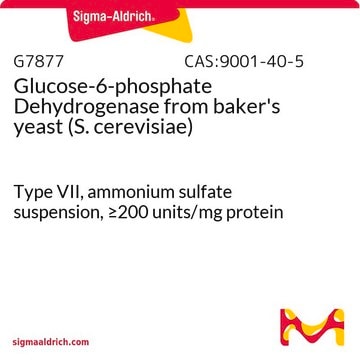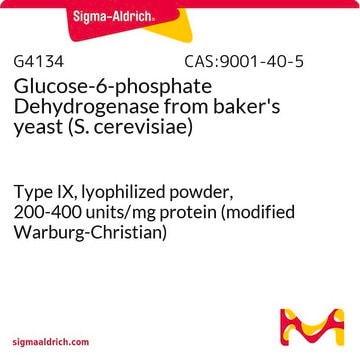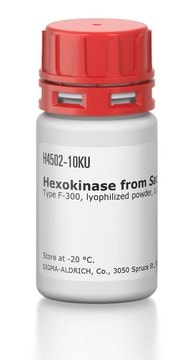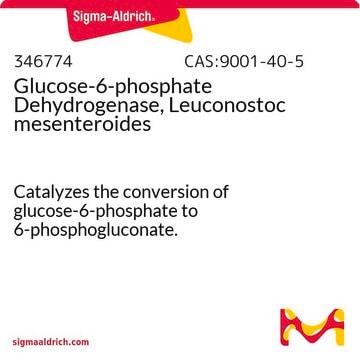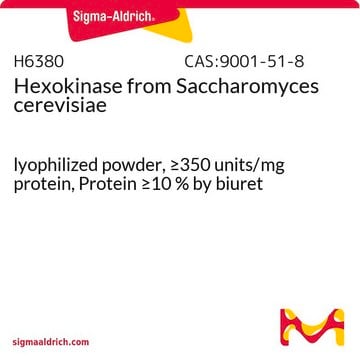G8404
Glucose-6-phosphate Dehydrogenase from Leuconostoc mesenteroides
recombinant, expressed in E. coli, ammonium sulfate suspension, ≥550 units/mg protein (biuret)
Synonim(y):
Entner-Doudoroff enzyme, G6PD, G6PDH, NADP glucose 6-phosphate dehydrogenase, G-6-P-DH
About This Item
Polecane produkty
pochodzenie biologiczne
bacterial (Leuconostoc mesenteroides)
Poziom jakości
rekombinowane
expressed in E. coli
Postać
ammonium sulfate suspension
aktywność właściwa
≥550 units/mg protein (biuret)
masa cząsteczkowa
128 kDa
warunki przechowywania
(Tightly closed)
metody
cell culture | mammalian: suitable
numer dostępu UniProt
obecność zanieczyszczeń
creatine phosphokinase, glutathione reductase, myokinase, NADH oxidase, NADPH oxidase, phosphoglucomutase, 6-phosphogluconic dehydrogenase, phosphoglucose isomerase, lactic dehydrogenase, hexokinase ≤0.01%
temp. przechowywania
2-8°C
Szukasz podobnych produktów? Odwiedź Przewodnik dotyczący porównywania produktów
Powiązane kategorie
Opis ogólny
Research area: Cell Signaling
Zastosowanie
- to test ketose reductase activity in developing maize endosperm.
- to determine the levels of mannose in coronary heart disease patient-derived serum
- to study its activity on extracellular polymeric substance (EPS) extract to determine cell lysis through sonication
- to determine the glucose uptake in cultured human muscle satellite cells
Działania biochem./fizjol.
Definicja jednostki
Postać fizyczna
Kod klasy składowania
12 - Non Combustible Liquids
Klasa zagrożenia wodnego (WGK)
WGK 2
Temperatura zapłonu (°F)
Not applicable
Temperatura zapłonu (°C)
Not applicable
Środki ochrony indywidualnej
Eyeshields, Gloves, type ABEK (EN14387) respirator filter
Certyfikaty analizy (CoA)
Poszukaj Certyfikaty analizy (CoA), wpisując numer partii/serii produktów. Numery serii i partii można znaleźć na etykiecie produktu po słowach „seria” lub „partia”.
Masz już ten produkt?
Dokumenty związane z niedawno zakupionymi produktami zostały zamieszczone w Bibliotece dokumentów.
Klienci oglądali również te produkty
Produkty
Instructions for working with enzymes supplied as ammonium sulfate suspensions
Protokoły
To measure glucose-6-phosphate dehydrogenase activity, beta-nicotinamide adenine dinucleotide phosphate is used in a spectrophotometric rate determination assay at 340 nm.
Nasz zespół naukowców ma doświadczenie we wszystkich obszarach badań, w tym w naukach przyrodniczych, materiałoznawstwie, syntezie chemicznej, chromatografii, analityce i wielu innych dziedzinach.
Skontaktuj się z zespołem ds. pomocy technicznej

